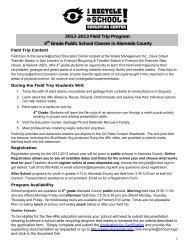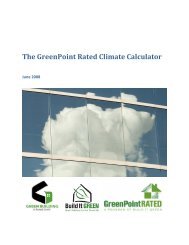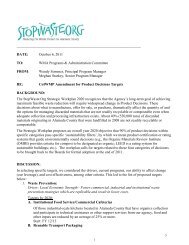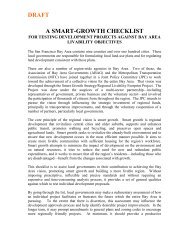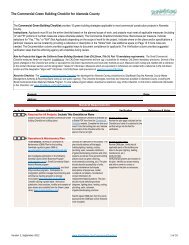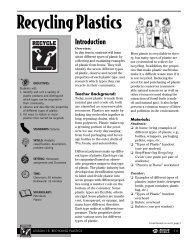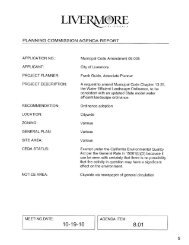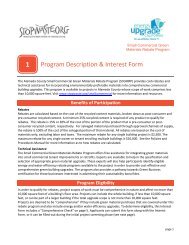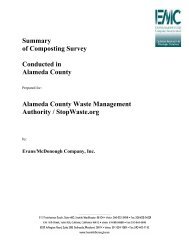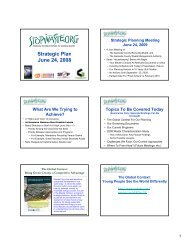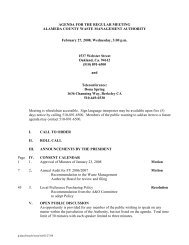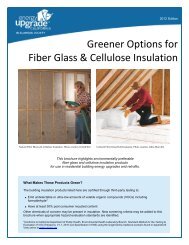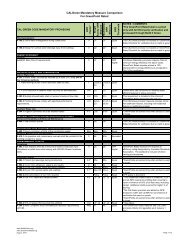Bay-Friendly Landscaping Principles and Practices - StopWaste.org
Bay-Friendly Landscaping Principles and Practices - StopWaste.org
Bay-Friendly Landscaping Principles and Practices - StopWaste.org
You also want an ePaper? Increase the reach of your titles
YUMPU automatically turns print PDFs into web optimized ePapers that Google loves.
5. Grasscycle<br />
Description<br />
Grass clippings have about 4% nitrogen<br />
in them. When they are left on the<br />
lawn, they can meet some of the lawn’s<br />
nitrogen needs, as well as supply an array<br />
of other nutrients.<br />
Applications<br />
n Leave the clippings on the lawn after<br />
mowing, except during the limited<br />
time of the year when the grass is too<br />
wet or too long.<br />
n Look for more detailed information<br />
in A <strong>Bay</strong>-<strong>Friendly</strong> <strong>L<strong>and</strong>scaping</strong> Guide<br />
to Grasscycling. Go to<br />
www.<strong>Bay</strong><strong>Friendly</strong>.<strong>org</strong> to download a<br />
free copy.<br />
6. Mulch regularly<br />
Description<br />
Mulch is any material spread evenly over<br />
the surface of the soil. Organic materials,<br />
including chipped l<strong>and</strong>scape debris,<br />
are preferable over in<strong>org</strong>anic materials<br />
because they supply nutrients over time.<br />
Nitrogen ‘drag’ is usually not a problem,<br />
even when woody materials are used.<br />
Applications<br />
n Keep 2-4 inches of an <strong>org</strong>anic mulch<br />
over the surface of the soil at all times,<br />
or at least until plants grow to cover<br />
the soil. Typically, larger particle size<br />
mulches are better for weed<br />
control.<br />
n Designate less visible areas, away from<br />
stormdrains, for leaves to remain as<br />
mulch after they fall.<br />
n Look for more detailed howto<br />
information in A <strong>Bay</strong>-<strong>Friendly</strong><br />
<strong>L<strong>and</strong>scaping</strong> Guide to Mulch. Go to<br />
www.<strong>Bay</strong><strong>Friendly</strong>.<strong>org</strong> to download a<br />
free copy.<br />
Benefits<br />
Mulch conserves water, enhances the<br />
growth of plants <strong>and</strong> the appearance<br />
of the l<strong>and</strong>scape. It can also simplify<br />
your operations — thereby lowering<br />
your costs — by suppressing annual<br />
weed growth <strong>and</strong> reducing the need for<br />
trimming around trees <strong>and</strong> poles.<br />
<strong>Principles</strong><br />
& <strong>Practices</strong><br />
Benefits<br />
Nutrients in the grass clippings are<br />
made available to plants. Fertilizer<br />
requirements can be reduced by as much<br />
as 50%, thereby lowering your costs <strong>and</strong><br />
protecting water quality.<br />
Grasscycling — leaving the clippings on the lawn after mowing — recycles nutrients <strong>and</strong><br />
saves time & money.<br />
photo: david gilmore<br />
Tips for Success<br />
Indicators of Quality Compost<br />
n Dark brown color<br />
n Sweet, earthy smell<br />
n Small, fairly uniform particle size<br />
n No weed sprouts<br />
n Feedstock is no longer recognizable<br />
n The producer can tell you the peak temperatures (<strong>and</strong> how long<br />
the compost stayed at those temperatures)<br />
n A nutrient analysis is available from the producer upon request<br />
n Compost is certified by the US Composting Council’s Seal of<br />
Testing Assurance (STA) Program.<br />
We’ll tolerate a<br />
little leaf debris in the beds,<br />
as long as it isn’t impeding<br />
plant health. Resourceefficient<br />
l<strong>and</strong>scaping is healthy<br />
l<strong>and</strong>scaping.”<br />
— Nate Silin, Owner, New Growth<br />
L<strong>and</strong>scape, Oakl<strong>and</strong><br />
30<br />
3



